Pipe cutter for plastic pipes: choosing the best model + instructions for use
Self-installation of water supply, sewerage or heating systems requires not only certain skills, but also special tools.One of them is a pipe cutter for plastic pipes, without which it is impossible to subsequently obtain high-quality welds.
To optimally select a tool model, you should familiarize yourself with the types of pipe cutters and the features of their operation.
The content of the article:
Classification and types of pipe cutters
There are a huge number of designs of household and industrial pipe cutters for plastic pipes, but the principle of their operation usually comes down to two options:
- roller;
- guillotine
Roller pipe cutters have from one to several dozen cutting elements mounted on rigid or movable bases. As they move around the pipe, the rollers gradually deepen into the plastic wall until it is completely cut off.
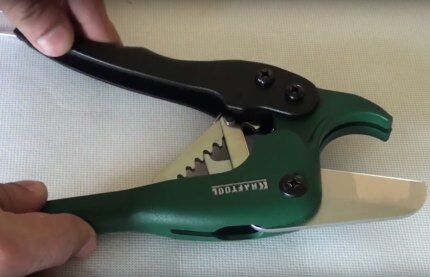
Structurally, roller tool models have virtually no complex mechanical elements, which is why their price is quite low.
With guillotine devices, the cutting edge is a strong blade that is pressed into the wall of the plastic pipe using manual force.Most models have a built-in ratchet mechanism, which makes the cutting process smooth and relatively easy.
Naturally, the devices differ in other parameters:
- diameter of processed pipes;
- types of materials available for work;
- the maximum wall thickness that the device can cut;
- presence of electric drive.
The maximum diameter of pipes for cutting with manual devices is 110 mm. This is the thickness of the sewer pipe for the toilet or in-house riser. But most tools are limited to a diameter of 50-63 mm.
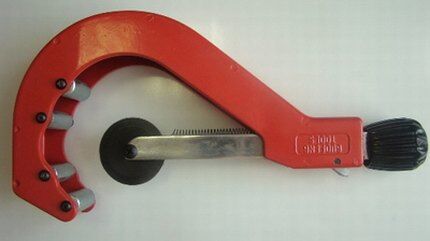
The maximum wall thickness of a plastic pipe is limited only for roller pipe cutters, so their selection should be made based on this parameter. Cutting wheels with the required blade height can be purchased additionally.
The bonus of roller models is their possible versatility regarding the materials being processed. There are pipe cutters that are designed exclusively for working with plastic material. But there are also those that can saw through steel, copper, stainless steel and other types of metals at the same time.
Electrically driven devices are expensive, so they are purchased mainly by professionals. But if there are sufficient financial resources, anyone can purchase them and make the work of installing plastic wiring easier.
Roller type pipe cutter
The roller pipe cutter works smoothly, without cutting forces across the pipe, so the cut is smooth and without nicks.
Device and technical characteristics
The roller tool consists of the following elements:
- Clamp body for enclosing the pipe.
- A screw handle that acts as a clamping mechanism.
- Cutting rollers attached to the end of the clamp.
- Carriage with steel support rollers.
- A chamfer remover built into the bracket (more advanced models are equipped with it).
The advantages of a roller pipe cutter are its low cost and the absence of lateral pressure on the surface during cutting. This allows it to work even with thin material without the risk of damage to the pipe by the clamping force.

The disadvantage of a roller cutter is the need to rotate the tool. If the pipe is already rigidly fixed close to the wall, then cutting it off will be problematic.
The principle of working with a roller device
To cut a pipe with a roller pipe cutter, you need to perform the following list of steps:
- Insert the pipe with the marked cutting point into the center of the clamp.
- Use the screw handle to press the roller to the mark.
- Turn the pipe cutter once around the pipe and look at the correct shape of the resulting groove.
- Using the clamping mechanism, press the roller deeper into the pipe wall and rotate the tool 2 turns around the pipe. Repeat until the product is completely cut.
Helpful Tips:
The result of cutting with a roller pipe cutter is characterized by the absence of burrs and strict perpendicularity of the resulting pipe end.
Pipe cutter with chain mechanism
A chain pipe cutter is a device for cutting pipes without reference to their diameter. It's incredibly practical, but the cost of quality models puts off most buyers.
Design and properties of the chain mechanism
A chain pipe cutter resembles regular pliers, with a long chain attached to the ends. Its links are connected using a hinge mechanism. The chain is in most cases non-separable, so it requires complete replacement if one link breaks.
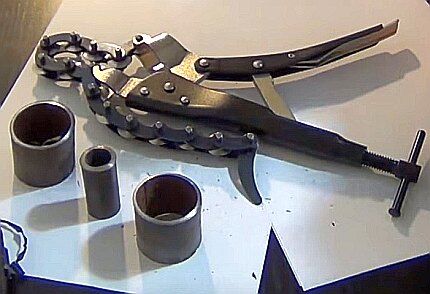
One end of the chain is rigidly fixed to the end of the tool handle, and the second is free. At the end of the second handle there is a special hook onto which, depending on the diameter of the pipe, the corresponding chain link is attached.
The tension force is created manually by bringing together the two handles of the tool, although there are pipe cutters with a screw clamping mechanism.
Depending on the mounting pattern of the cutting elements, a chain pipe cutter can be of two types:
- Mobile. The cutting rollers are mounted directly on hinges and can rotate during the cutting process.
- Fixed. The cutting elements are rigidly attached to the chain links without turning during operation.
There are chain pipe cutters in which the cutting effect is formed solely due to the pressing force, but they are practically not used for plastic pipes.
The advantages of chain pipe cutters are:
- high cutting speed due to many simultaneously operating cutting elements;
- with five chain links, the angle of mutual overlap of the cuts is only 72 degrees, which allows them to work in confined spaces;
- minimal pipe deformation due to multiple support points;
- ability to cut pipes with a wide range of diameters;
- high quality seam and minimal number of burrs.
The only disadvantage of chain pipe cutters is the high cost of their purchase, repair and maintenance.
Chain pipe cutting technology
Using a chain pipe cutter is quite simple. To cut a pipe, you must perform a series of sequential steps:
- Mark the cut location on the pipe.
- Wrap the chain around the pipe so that the cutting rollers are exactly at the level of the mark.
- Secure the chain link with maximum tension to the hook grip of the device handle.
- If there is a tension screw, tighten it with force until the cutting elements stop against the pipe wall.
- Rotate the tool in both directions while cutting. As you cut, you need to tighten the tension screw or increase the tension by bringing the handles of the pipe cutter together.
It is necessary to rotate the tool until the pipe is completely separated.
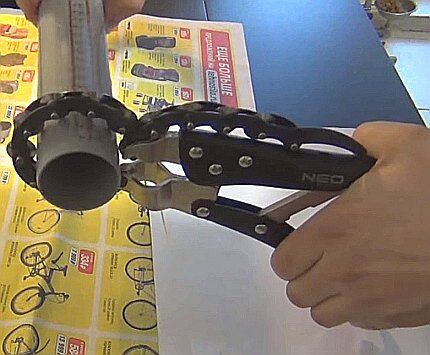
Despite the high-quality cut obtained, it is advisable to additionally process the pipe with a trimmer and chamfer.
Pipe cutter with ratchet mechanism
A guillotine pipe cutter with a ratcheting mechanism is also called scissors. It has a built-in mechanism that allows you to cut the pipe with a blade not with a single movement, but with repeated applied force, which reduces physical stress on the arm muscles.
Structure and properties of scissors
A guillotine pipe cutter is similar to an adjustable wrench with two handles. It has one molded handle ending in a wide C-shaped base to secure the pipe, and a second handle that presses the cutting blade down via a ratchet mechanism.
The tool is equipped with a button to return the cutter to its original position and a closed state lock for easy transportation.
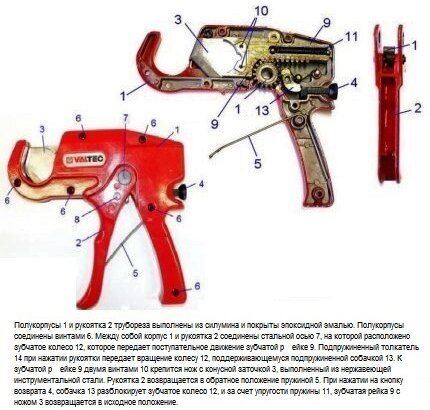
The working diameter of the scissors varies from 3 to 75 mm. A special feature is the sharp increase in the cost of the device with an increase in the maximum possible pipe thickness above 42 mm.
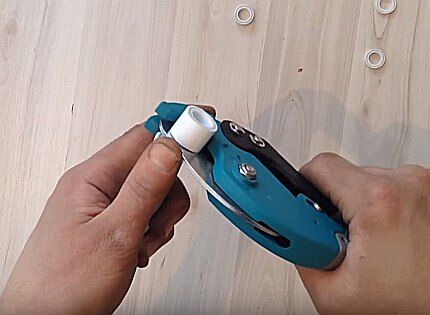
Manufacturers try to design the cutter and blade to minimize the required workspace. Blades can be smooth or serrated. Some models are equipped with a built-in chamfer, but the end of the pipe is processed after cutting, and not simultaneously with it.
The advantages of a guillotine pipe cutter are:
- low cost of the tool;
- possibility of cutting in confined spaces;
- using only one hand when working;
- absence of chips and burrs when cutting.
Scissors also have a lot of disadvantages:
- Fatigue of hands due to large volumes of work.
- The need to sharpen blades.
- High cost of replacement blades.
- Transverse deformation of pipes during cutting.
- There is a chance of purchasing an inexpensive tool that will become dull after a dozen cuts.
- Limited maximum pipe diameter.
Despite the disadvantages, guillotine modifications are an ideal option for installing plastic pipes of small diameters for small volumes of work.
How to use pipe cutters?
The cutting process with a guillotine turbo cutter differs little from working with conventional scissors, but has its own characteristics.
To cut a pipe with this tool, you need to do the following:
- Draw the cut location on the pipe.
- Place the pipe on the wide base of the pipe cutter so that the intended cut strip is exactly opposite the blade.
- Using the handle, press the blade onto the pipe.
- After each full squeeze of the handles, loosen them, returning them to their original position.
You should repeat the rhythmic squeezing of the tool handles until the pipe is completely cut.
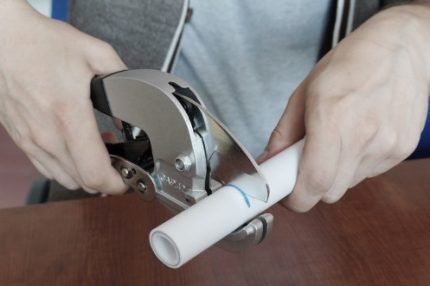
A number of tools have a ratchet mechanism, each click of which notifies the movement of the internal ratchet mechanism by one tooth. The sound of a click means that you can now unclench the handles of the instrument and repeat the pressing from a more comfortable position.
You can read more about how to use scissors for cutting plastic pipes in this material.
Electric pipe cutters for plastic pipes
The electric drive of pipe cutters greatly facilitates and speeds up the installation process.
There are three types of electric pipe cutters:
- tools that simply copy the principle of a guillotine or roller mechanism;
- industrial stationary equipment with complex internal structure;
- universal tools for cutting materials.
These types of tools should be considered in more detail.
Reciprocating electric saw
Reciprocating saws are similar in principle to a jigsaw. They have an electric drive, with the help of which the serrated blade makes rapid reciprocating movements. The length of the files starts from 100 mm, and the width and height of the teeth varies depending on the material being processed. For plastic, a tooth pitch of 4 mm is used.
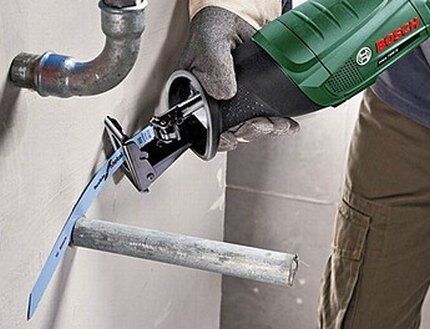
An additional piece of equipment that makes cutting with a reciprocating saw easier is a chain or C-shaped pipe clamp. It is fixed to the body of the power tool with a special fastener.
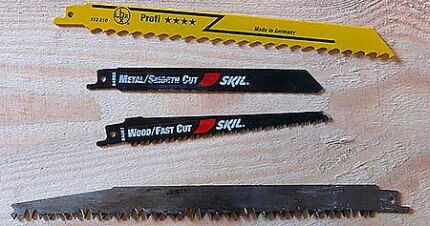
The advantages of reciprocating saws when cutting plastic pipes are:
- work safety;
- low cost of removable blades;
- high cutting speed;
- ability to work with pipes of any diameter;
- the ability of the blade to bend and cut pipes flush with the wall;
- durability;
- the price of a household electric saw is comparable to the cost of a professional guillotine pipe cutter.
The disadvantages of reciprocating electric saws include:
- The need for a local source of electricity.
- The resulting cut requires additional processing with a trimmer or chamfer.
- It is difficult to ensure the perpendicularity of the seam without a special pipe clamp.
- Difficulty in cutting without fixing the pipe in a vice.
You shouldn’t buy a reciprocating electric saw specifically for cutting plastic pipes, but if you already have one, you can use it. This tool can be useful on the farm for cutting metal, trees, bricks and other materials.
Roller and guillotine electric pipe cutters
This category of power tools for cutting plastic pipes has all the advantages and disadvantages of the corresponding manual equipment. Roller and guillotine electric pipe cutters greatly facilitate the cutting process, but their cost is several times higher than mechanical tools.
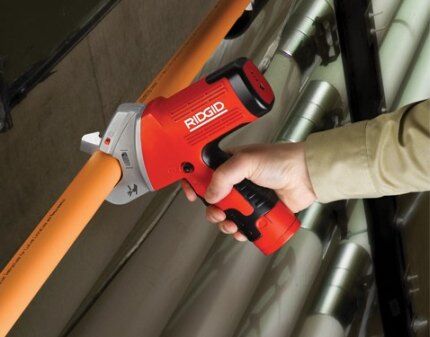
In design, power tools resemble their hand-held counterparts only schematically, because they have a complex internal filling.
Pipe cutters can have two sources of electricity: a household electrical network or a battery.

Cordless tools are the most expensive, but allow you to carry out work without reference to the terrain. Their prices start at $150. The charge should be enough for 1-2 hours of continuous operation. This is quite enough for installing home plumbing.
Industrial professional pipe cutters
Industrial machines can cut pipes of any size, not just large ones.
This equipment can be divided into several categories, depending on the design features:
- Electric.
- Pneumatic.
- Hydraulic.
- Orbital type.
- With automatic control system.
The cost of such pipe cutters starts from several hundred dollars, so they are used mainly by professional installers.
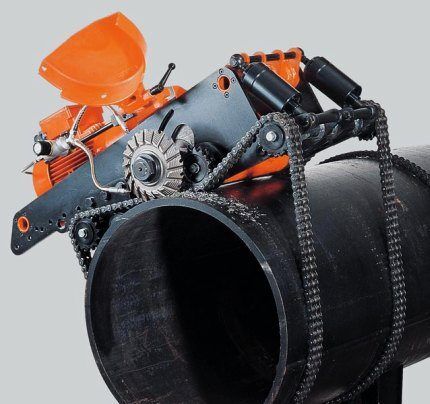
Their advantage is the automatic regulation of the speed of movement and pressure parameters of the cutting element, as well as the combination of cutting with the process of chamfering and cleaning the cut from burrs.
There are also several more articles on our website that are devoted to the selection of equipment for cutting pipes. We recommend reading them too:
- types of pipe cutting equipment;
- pipe cutters for metal-plastic pipes;
- tool for cutting steel pipes;
- popular pipe cutters for polypropylene pipes.
Rules for choosing a pipe cutter for work
The choice of the optimal model depends on the amount of work, the type of pipes, the laziness of the person and his financial capabilities. The cost of tools similar in appearance and structure can differ by 3-5 times, so it is necessary to select a tool, also taking into account the quality factor.
Next, we will consider a list of works and the types of tools recommended for them:
- One-time installation of residential water supply or heating: guillotine shears.
- One-time installation of apartment sewerage: roller or chain pipe cutter, reciprocating electric saw.
- Regular work with pipes in a country house: roller or guillotine devices with electric drive, reciprocating electric saw.
- Cutting plastic pipes with a diameter of less than 50 mm: guillotine pipe cutter.
- Cutting plastic pipes with a diameter of 50 mm and thin-walled pipes: chain or roller pipe cutter.
These recommendations are indicative, so the final choice of model should be made taking into account the entire range of influencing factors.
Conclusions and useful video on the topic
The presented videos demonstrate work with pipe cutters for various types of plastic pipes.Viewing them will allow you to better understand the principle of working with these tools and make the right choice when purchasing a pipe cutter.
Operating principle of a roller pipe cutter:
Review of manual pipe cutters:
Cutting with a chain pipe cutter:
Reciprocating Saw Review:
Pipe cutter for guillotine type pipes:
Choosing a tool for cutting pipes is not an easy task due to the many design options and wide price range. For one-time household work, the cheapest models are suitable, capable of withstanding several hundred cuts without compromising quality.
If you have enough money, it is better to immediately purchase a professional electric pipe cutter with automatic chamfering. It is advisable to make the final choice directly in the store, taking into account the advice of the sellers.
If you have experience using pipe cutters for plastic pipes, please share it with visitors to our site. Tell us what tool you use, about its advantages and disadvantages that were noticed in your work. Please leave comments in the block below.




So I looked - there are no normally working inexpensive pipe cutters. I don’t want to pay a lot of money for a situational tool. Can anyone recommend a budget pipe cutter?
Hello. If you do not often use a pipe cutter and use it for personal purposes, of course it is best to purchase the simplest model in the form of scissors. These are often included with pipe soldering irons. It is important to look at the build quality and ease of use. I can’t say for a specific brand; good is a relative concept. Some people find one modification convenient, others another.Another thing is that their quality, due to their simple design, is immediately visible.